2024 Mercedes-Benz eSprinter Is The Two-Seat, RWD Electric Vehicle The U.S. Needs

It’s not every day that I get to drive a new two-seat, rear-wheel-drive vehicle, especially not one from a premium brand like Mercedes-Benz. Even rarer, for now at least, is when such a vehicle has an electric powertrain and is built here in America. On this sunny day in Newport Beach, California I’m driving Mercedes’ newest EV, which fits all of those criteria and is turning a ton of heads.
Cristo Fernandez Is Playing His First Car In The New ‘Transformers: Rise Of The Beasts’
Oh, did I mention that the EV in question is a cargo van, and the heads it’s turning are mostly those of other van drivers? Yeah, that explains it. The 2024 eSprinter is the first electric van offered by Mercedes-Benz in the U.S., and it’s the next prong in the brand’s strategy to go fully electric where it can by 2030.
Full disclosure: Mercedes-Benz invited me to Newport Beach to drive the eSprinter, and as a lover of vans, I had to say yes. Mercedes put me up in a nice hotel across the street from a fancy mall and brought me to Nobu for dinner, which was one of the best vegetarian meals I’ve ever had. The day after the event I drove back up to LA in the pouring rain and my R129’s roof didn’t leak, so it was a success all around.
Not only is the eSprinter Mercedes’ first EV van for the U.S., it’s launching at the same time in Europe — until now, Mercedes only offered electric versions of the Metris and V-Class overseas. The eSprinter will be produced at two different factories in Germany and a plant in North Charleston, South Carolina, and Mercedes says the van’s production is net carbon neutral. Half a million Sprinters have been sold in the U.S. since it was introduced in 2006, with America being the second-largest market after Germany.
Photo: Daniel Golson/Jalopnik
At launch in the U.S. Mercedes will only be offering one eSprinter configuration: a cargo van with the longer 170-inch wheelbase and the high roof. On the internal-combustion Sprinter you can get a 140-inch wheelbase or get 170-inch one with a longer body, and there’s also a standard roof height option. Expect those to be available after the first model year or so, as will non-cargo versions eventually. Aside from the lack of exhaust tips and the different badging there’s no real way to tell the difference between a gas Sprinter and an eSprinter, and the EV is available in 22 colors including multiple reds, an amazing teal green, the retro China Blue and even a bright pastel yellow.
Mercedes engineered the eSprinter’s powertrain to consist of three separate “modules.” The first is all of the high-voltage components, which are found under the hood and are the same across every version of eSprinter regardless of configuration. The second is the batteries, which are found under the floor between the axles, and the third module is the rear axle and its integrated electric motor.
Customers can order the 2024 eSprinter with either 134 horsepower or 201 hp; regardless of power the rear-mounted electric motor puts out 295 pound-feet of torque, and every eSprinter has a 113-kWh battery pack. Mercedes doesn’t quote a 0-to-60 mph time, but says the eSprinter’s maximum torque can be delivered for “at least” 30 seconds and the van has a top speed of 75 mph. The maximum payload is 2,624 pounds while the max GVWR is 9,370 pounds and the GCWR is 11,023 pounds. That means there’s no four-wheel-drive model yet, which is a major reason vanlifers love the Sprinter, and there’s also not yet an electric equivalent to the 3500 and 4500 versions.
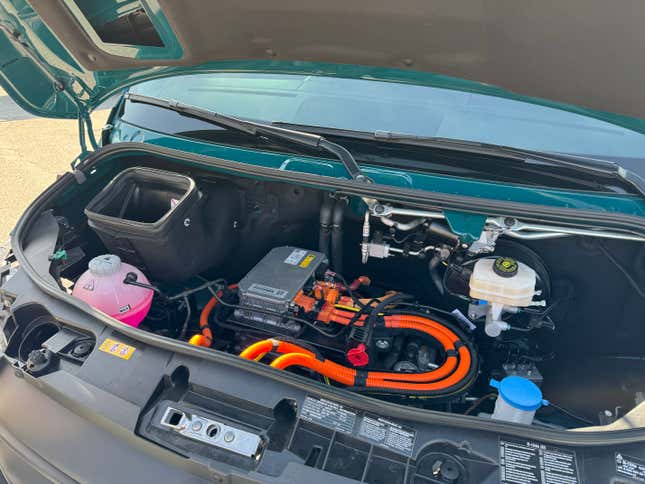
Photo: Daniel Golson/Jalopnik
We don’t have U.S. range estimates yet, but Mercedes says the eSprinter has an overall range of 273 miles on the European WLTP cycle and a WLTP city range of 329 miles, and the EPA range will probably end up in the low 200s. The eSprinter can DC fast-charge at up to 115 kW — more than double what a Chevy Bolt can do — which is good enough to replenish the battery from 10 to 80 percent in about 42 minutes. Plug into a 240-volt wallbox and it will take about 12 and a half hours to fully charge the battery from 0 to 100 percent. The charging port, which still uses the CCS connector, is integrated into the large Mercedes logo in the front grille — just press on a corner of the surround and the logo pops open to reveal the port. Mercedes says this location is ideal for a large vehicle like the Sprinter, as most charging stations have pull-in parking spots.
With well positioned steps and grab handles climbing into the Sprinter is easy, and from behind the wheel it doesn’t feel foreign. It has a regular Mercedes-Benz steering wheel, analog gauges with a screen in between them, physical climate control buttons, and a large panel sitting atop the center of the dash that has an integrated 7-inch touchscreen running the MBUX infotainment system, physical media controls and two large air vents. Optional is a larger 10.25-inch touchscreen that you get in other Benzes, with navigation and a number of other useful connectivity features.
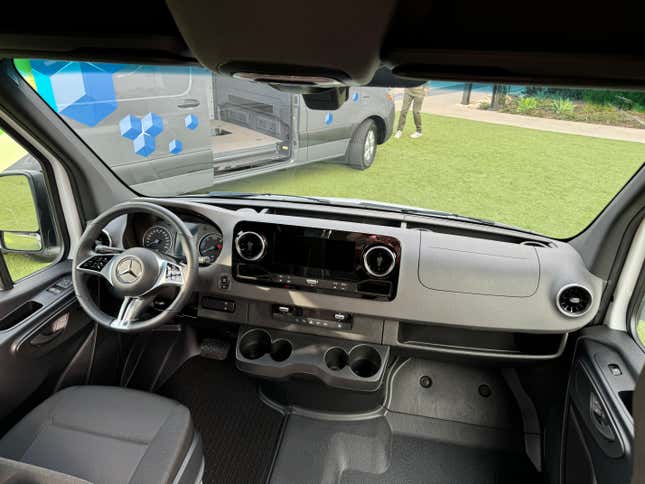
Photo: Daniel Golson/Jalopnik
The eSprinter has three different drive modes. Comfort is the standard mode, giving drivers the full power amount, while Eco limits the motor’s output for better efficiency. Eco mode definitely makes the eSprinter feel slower, but it’s still plenty for getting around. Then there’s the Maximum Range mode, which seriously reduces power and limits the use of features like climate control. In the range mode I need to floor the accelerator for a while to even reach 30 mph — it’s ok for low-speed city driving, but probably not suitable for anything else.
Luckily, in Comfort mode the eSprinter feels downright quick. It can more than keep up with other cars and has no trouble merging onto the freeway, and while you don’t get the same gut-punch acceleration as in a regular electric car, the eSprinter’s instantaneous torque is really satisfying and it continues to pull up to the 75-mph top speed. The steering is light and direct, and as someone without much van-driving experience the eSprinter is really easy to maneuver through traffic.
There are also three different regenerative braking settings, the most powerful of which doesn’t quite achieve one-pedal driving but is strong enough to perform the majority of the deceleration, and the transition to hitting the actual brake pedal is smooth. The eSprinter has an Auto mode for the regen that adjusts itself based on the road and traffic conditions, which is nice for coasting on the freeway but not reactive enough in city driving for my tastes.
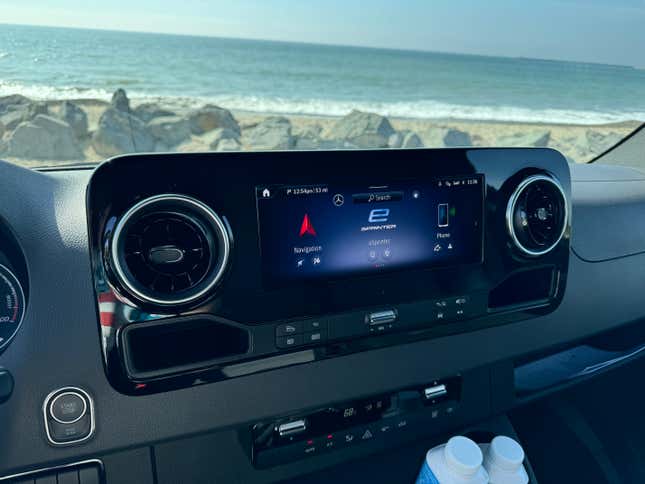
Photo: Daniel Golson/Jalopnik
When I first hop into an eSprinter with a 99-percent charge the gauge cluster shows a 181-mile range in Comfort mode. Seventy miles of driving later — including stop-and-go in the city, climbing up and over some large hills, and a good deal of highway cruising — the van’s charge is at 67 percent and shows 129 miles of range. With climate control on and not trying to drive particularly efficient, my drive partner and I average 2.0 miles per kWh overall, seeing as high as 2.6 mi/kWh in some sections, which is pretty impressive for a vehicle like this. Mercedes says its engineers did 275 miles in a single charge, driving from Las Vegas to Long Beach.
Visibility out of the front is really great, and the large split side mirrors provide a surprisingly good view of the side of the van. You’ll definitely want to opt for the $736 digital rear-view mirror, though the available rear window is easier to see out of than I expected, and blind-spot monitoring and rear cross-traffic alert are also available for $504. If it weren’t for the tall ceiling and more upright seating position — I can’t recline the seatback because of the bulkhead directly behind me — I would forget that I’m in a huge cargo van.
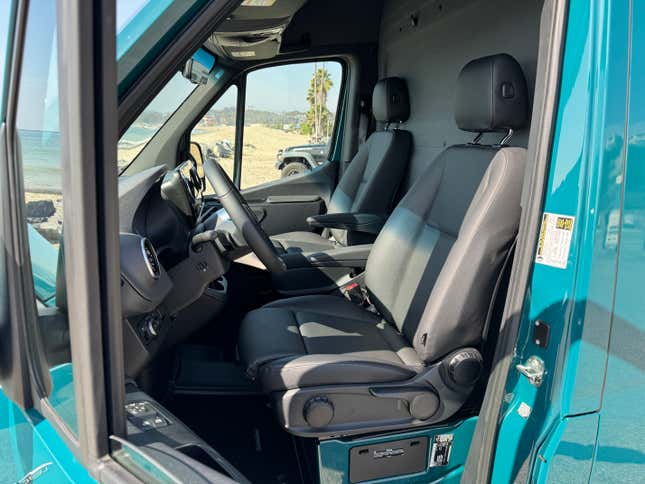
Photo: Daniel Golson/Jalopnik
It’s also a lot more comfortable than I expected, especially when compared to other big vans. All of the eSprinters I’m driving have a 440-pound payload strapped into the cargo area, which definitely helps out in the ride-quality department, as does the existence of that big battery pack. It’s pretty quiet, too, both in terms of wind and road noise. (It definitely gets blown around more by gusts of wind than a regular car, though, an unsettling experience I forgot would probably happen.) Sitting at a light without the noise and vibrations from an internal combustion engine really makes driving the eSprinter a relaxing affair, with the electric torque and modern equipment further lessening the stress.
The eSprinter is available to order now, and it’s pricey. Including a $2,295 destination charge the standard model starts at $74,181, and the high-output model costs $77,611. That’s a fairly big jump up from the internal combustion Sprinter, which starts at $58,795 for an equivalent body configuration. It gets even pricier when you start loading it up with options, many of which its competitors can’t get like heated seats and steering wheel, automatic climate control, LED lights and power sliding doors. I’m able to configure an eSprinter up to $89,552, and that’s without adding any factory accessories.
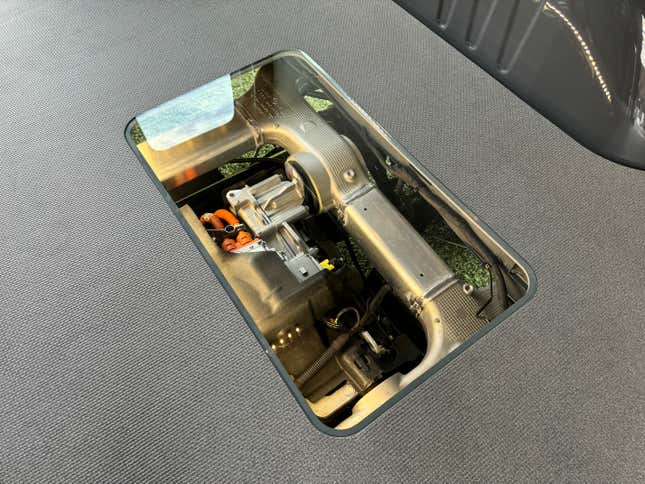
Sadly, a transparent panel to view the electric motor won’t actually be an optionPhoto: Daniel Golson/Jalopnik
Ford’s E-Transit starts at $51,890 for the shortest, lowest van or $57,890 for the tallest, longest one (still not as long as the eSprinter). Pricing for the recently revealed Ram ProMaster EV hasn’t been announced yet, but it will probably be much closer to the Ford than the Mercedes in price. The E-Transit is a little more powerful and charges a bit quicker than the eSprinter but only has a range of up to 126 miles (108 for the bigger van), and the ProMaster EV has a 162-mile range and 150-kW charging, but it’s front-wheel drive. Both American vans have better payload figures, but they’re based on older models than the Mercedes, and the Sprinter definitely has the nicest interior and driving dynamics.
All three vans feel like stopgaps before more dedicated electric vans hit the market in a few years. EV powertrain tech is improving so rapidly, and this new eSprinter will probably be outdated not only in specs but also design and feature content when Mercedes’ modular VAN.EA platform comes out in 2026. A dedicated electric architecture, VAN.EA will underpin both midsize and large commercial vans as well as luxury passenger vans — that’s right, we’ll finally get the V-Class.
That doesn’t mean the eSprinter won’t be important until then. It’s an absolute no-brainer for vans like this to go electric, even disregarding them being plain better to drive than internal-combustion counterparts. The proliferation of electric vans and other commercial vehicles will make cities much quieter, cleaner and energy-efficient, something I’ve already experienced in other countries. According to the U.S. Department of Energy, delivery vehicles and light-duty vans drive an average of around 12,000 miles a year, equalling out to a few dozen miles per day. In the vast majority of work use cases, eSprinter drivers won’t ever need to charge to get the job done. Once van drivers experience electrification, I think it’ll be hard to go back.
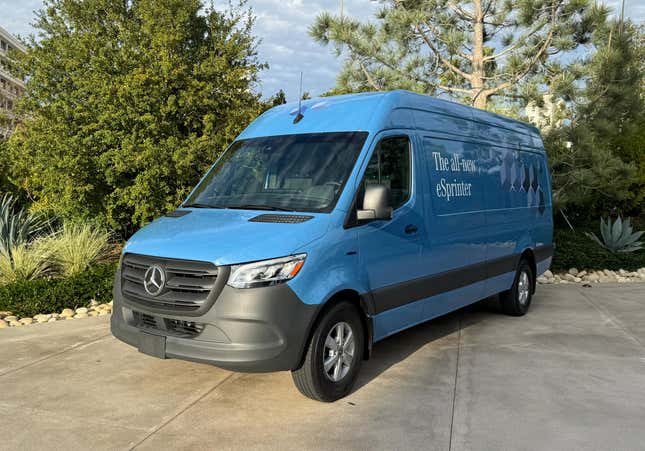
Photo: Daniel Golson/Jalopnik
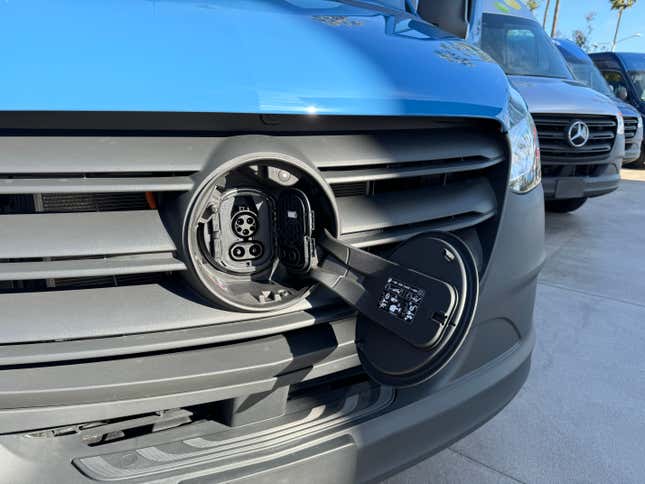
Photo: Daniel Golson/Jalopnik
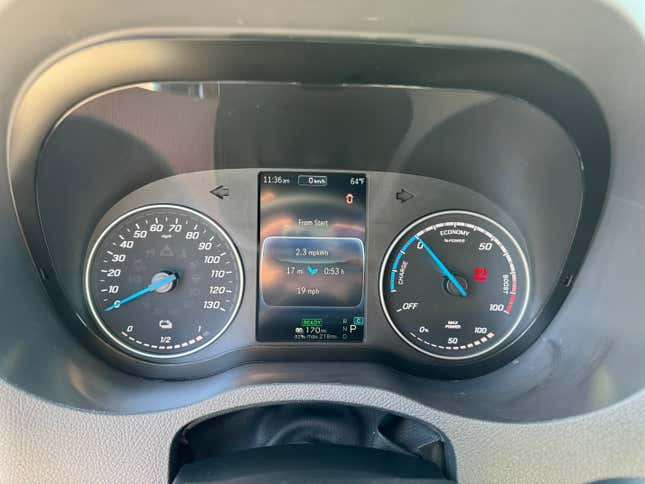
Photo: Daniel Golson/Jalopnik
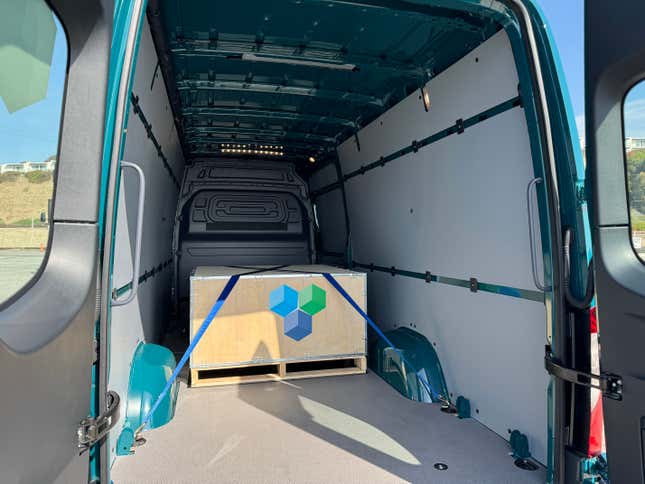
Photo: Daniel Golson/Jalopnik







